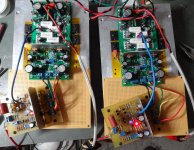Hi Valery
cob = 500pF and 40MHz FT for 2SA1216
http://www.onsemi.com/pub_link/Collateral/NJW0281-D.PDF : NPN/PNP Gain Matching within 10% 400pF 30Mhz
Sorry - you're right, I looked at NPN 🙂
Anyway, this pair performs very well in power amps - used them a lot
Overall speed is good enough - never provoked stability issues
Sorry - you're right, I looked at NPN 🙂
Anyway, this pair performs very well in power amps - used them a lot
Overall speed is good enough - never provoked stability issues
The own issue is the reliability as many of them that are circulating in shops are fake ones as they are discontinuted devices...
I try them in VSSA BJT version but they was a notable sound difference between them and MJL4281/4302(ordered on onsemi website). I try differents bias level on them they was always more dark and less clean at details transcription.
Marc
Hi Terry ,look at the post#1531.Yes, they are sitting side by side, powered from the same PSU. Voltages are very close to the same. The troubled board pulls slightly more current through the CM when playing music. I assume that is due to the oscillation since the bias rises more than the good channel. It is 5am here so I haven't had a chance yet to try any of the suggestions yet. I will in a couple hours.
Thanks, Terry
Swap the VAS PCB and observe if oscillations follows to another output PCB.
That was the first thing I tried. I naturally suspected the IPS first. I tried several different IPS units before settling on the ops as the culprit. I will be working on the boards shortly. I'll report back.
Blessings, Terry
I used my EF3 OPS (KSC3503D/KSA1381E + 2SC4793/2SA1837 + 2SC2922/2SA1216) with VFA, i combine small caps (100pF) with 100R base resistors for pre-driver trans. No problem with oscilation.
Single EF vs Double EF
Alright. Lynx setup gave me some hard time - I've got a Gigabyte motherboard with known problem with regards to PCI. After some tricks - it works. And I tell you - it's an outstanding card. Simply connecting input to its output (external loopback) gives me THD not higher than 0.0004% even at 20KHz. First picture is 1KHz loopback spectrum Very convenient balanced XLR plugs, converters to unbalanced RCA are included.
Very convenient balanced XLR plugs, converters to unbalanced RCA are included.
Here is some stuff for you to consider.
I have measured the setup with single EF. Then I have added the second EF (NJW3281/1302) and measured again (some resistor values were adjusted to keep the EFs in the right regimes as the bias is changed).
Well... THD decreased 1.5 times in average. Not really a lot.
IMD is roughly the same (I show only one of them).
Square waves are the same (again, showing one of them @ 20KHz).
There is one advantage of a single EF option though. If no load is connected, additional pole, introduced by the double EF OPS, moves above the unity gain line. With single EF OPS it's not visible (on the right, above 1MHz?). So, single EF setup seems to be potentially more stable in "non standard" conditions (my rough supposition, I did not dig deep into it).
All for now. I seem to prefer a single EF option... though, in the evening I will run a couple of additional tests with a bit lower quiescent current for the EF (trying to run it "cooler"). It would be also interesting to match the EF transistors - at the moment I've got hfe of 125 for PNP and 75 for NPN - don't have any better match at the moment.
Cheers,
Valery
Alright. Lynx setup gave me some hard time - I've got a Gigabyte motherboard with known problem with regards to PCI. After some tricks - it works. And I tell you - it's an outstanding card. Simply connecting input to its output (external loopback) gives me THD not higher than 0.0004% even at 20KHz. First picture is 1KHz loopback spectrum
 Very convenient balanced XLR plugs, converters to unbalanced RCA are included.
Very convenient balanced XLR plugs, converters to unbalanced RCA are included.Here is some stuff for you to consider.
I have measured the setup with single EF. Then I have added the second EF (NJW3281/1302) and measured again (some resistor values were adjusted to keep the EFs in the right regimes as the bias is changed).
Well... THD decreased 1.5 times in average. Not really a lot.
IMD is roughly the same (I show only one of them).
Square waves are the same (again, showing one of them @ 20KHz).
There is one advantage of a single EF option though. If no load is connected, additional pole, introduced by the double EF OPS, moves above the unity gain line. With single EF OPS it's not visible (on the right, above 1MHz?). So, single EF setup seems to be potentially more stable in "non standard" conditions (my rough supposition, I did not dig deep into it).
All for now. I seem to prefer a single EF option... though, in the evening I will run a couple of additional tests with a bit lower quiescent current for the EF (trying to run it "cooler"). It would be also interesting to match the EF transistors - at the moment I've got hfe of 125 for PNP and 75 for NPN - don't have any better match at the moment.
Cheers,
Valery
Attachments
-
 06-THD-20KHz.JPG287.2 KB · Views: 148
06-THD-20KHz.JPG287.2 KB · Views: 148 -
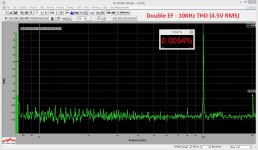 06-THD-10KHz.JPG285 KB · Views: 151
06-THD-10KHz.JPG285 KB · Views: 151 -
 06-THD-01KHz.JPG285.4 KB · Views: 159
06-THD-01KHz.JPG285.4 KB · Views: 159 -
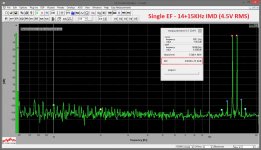 05-zIMD-14-15KHz.JPG305.9 KB · Views: 153
05-zIMD-14-15KHz.JPG305.9 KB · Views: 153 -
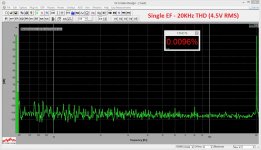 05-THD-20KHz.JPG289.4 KB · Views: 161
05-THD-20KHz.JPG289.4 KB · Views: 161 -
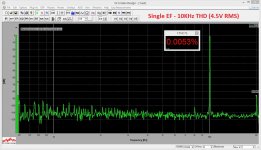 05-THD-10KHz.JPG291.2 KB · Views: 429
05-THD-10KHz.JPG291.2 KB · Views: 429 -
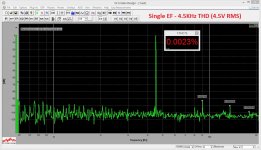 05-THD-04KHz.JPG295.6 KB · Views: 446
05-THD-04KHz.JPG295.6 KB · Views: 446 -
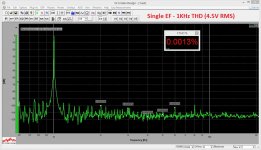 05-THD-01KHz.JPG295 KB · Views: 450
05-THD-01KHz.JPG295 KB · Views: 450 -
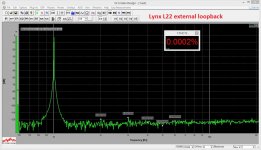 04-THD-01KHz-LB.JPG285.5 KB · Views: 481
04-THD-01KHz-LB.JPG285.5 KB · Views: 481 -
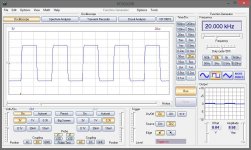 07-SQR-20KHz.JPG140 KB · Views: 180
07-SQR-20KHz.JPG140 KB · Views: 180
Double EF with MOSFET OP devices seems like an overkill to me.
Agree

Also, a little bit of 2-nd harmonic (really a little bit) is never a problem 😉
Last edited:
May I ask, aside from using the ops boards to play with this on, what does this have to do with the OP topic? Is it improving slew? Does it compare CFA and VFA? Seems like a huge departure from the theme of this thread. What is the goal here?
Thanks, Terry
Thanks, Terry
It's about the MOSFET option of SlewMaster OPS, initially developed by OS, using Jason's PCBs. Suitable for both CFA and VFA designs, though I did not compare the slew rates yet. The point is that MOSFETs and BJTs have got different distortion profiles, so they are expected to sound somewhat different (and they do, according to my initial tests).
I believe, it's a cool addition to the existing set of options in the "modular" framework, introduced by Ostripper here, especially with the fact that no PCB changes are needed and less parts are involved in overall. Some people seem to be interested...
I can actually move further discussion to one of my threads (like hybrid front-end, I'm testing it with) or create a new one - no problem at all 🙂
Cheers,
Valery
I believe, it's a cool addition to the existing set of options in the "modular" framework, introduced by Ostripper here, especially with the fact that no PCB changes are needed and less parts are involved in overall. Some people seem to be interested...
I can actually move further discussion to one of my threads (like hybrid front-end, I'm testing it with) or create a new one - no problem at all 🙂
Cheers,
Valery
I set the troubling OPS aside and finished the BabySlew boards since my parts came in. Plays beautifully with my Wolverine IPS. Very, very nice!
Great to hear that! A little success after so much trouble.😀
Valery, please keep the MOSFET OPS discussion here in this thread. It is relevant to the original purpose of this thread and is in any case the most interesting development for a long while. I'm confident that OStripper would endorse this discussion strongly.
May I ask, aside from using the ops boards to play with this on, what does this have to do with the OP topic? Is it improving slew? Does it compare CFA and VFA? Seems like a huge departure from the theme of this thread. What is the goal here?
Thanks, Terry
All threads like this evolve and take on a life of their own of sorts. Does some of this discussion depart from the original formula? Yes, I agree it does. On the other hand, does using MOSFETs in the OPS present a valid option? I believe it does; especially so when there is no physical modification required, just some changes in values / a few jumpers to exclude unnecessary components. Also, being modular allows us to experiment with any IPS, CFA, VFA, Hybrid or otherwise. I don't think OS would have disapproved had he been here. It's the chatter from those who have no direct interest that is a bigger issue.
The topic of CFA vs. VFA seems to have chilled out. I do think that certain individuals who aren't likely to ever build one have increased the level of 'static' here and honestly, that chaps me more than genuine exploration of the project itself, irrespective of which tangents present themselves that are related to the original premise. What we are left with is a pretty cool project that continues to evolve. Let's see where it goes. MOSFETs, tubes or otherwise.
For more direct discussion related to what we do have and can build, there is a new thread split from build related discussion >HERE<. Hopefully the trolls will stay here and let us get our builds on in peace
 .
.Hi Valery, please post a schematic diagram from your last configuration, like post#3712It's about the MOSFET option of SlewMaster OPS, initially developed by OS, using Jason's PCBs. Suitable for both CFA and VFA designs, though I did not compare the slew rates yet. The point is that MOSFETs and BJTs have got different distortion profiles, so they are expected to sound somewhat different (and they do, according to my initial tests).
I believe, it's a cool addition to the existing set of options in the "modular" framework, introduced by Ostripper here, especially with the fact that no PCB changes are needed and less parts are involved in overall. Some people seem to be interested...
I can actually move further discussion to one of my threads (like hybrid front-end, I'm testing it with) or create a new one - no problem at all 🙂
Cheers,
Valery
I think, this thread for people who want to experiment and learn how to design and build any amplifier with all possibilities topology. IPS topology and OPS topology.
I think, this thread for people who want to experiment and learn how to design and build any amplifier with all possibilities topology. IPS topology and OPS topology.
totally agree 🙂
Regards
Juan
- Home
- Amplifiers
- Solid State
- Slewmaster - CFA vs. VFA "Rumble"
